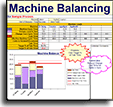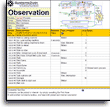Installation and Setup
Installation - Each User. Installation - Multi-user. Language Translations. Personalize Your Templates.Systems2win Training.
Quick Start Initial Training. New User Training. Training Matrix. Systems2win Leadership. Training Classes.Lean Training
Lean Training and Coaching. Lean Principles. Muda 8 Wastes. Goal - Lean Flow. Roadmap - Lean Journey. Value Stream Mapping. Standard Work. Hansei Lean Thinking. Lean Dictionary. Online Lean Training. Lean Leadership.Microsoft Office Training
Excel Training. Excel Drawings (without Visio). Excel Charts. Word Training. PDF Training. Document Storage and Naming.Support
Support.Kata Lean Coaching Cycle
aka Toyota Kata, Improvement Kata, Coaching Kata
What's a kata?
A kata is any structured way of thinking and acting that you practice until the pattern becomes a habit.
Through practicing, the pattern of behavior becomes second nature; so that you just "do what you do" with little or no conscious attention.


In your own life, you have experienced many real-world examples where you started out with very concentrated attention to learning a new skill, which soon became so ingrained and familiar that you now just do the basic patterns without thinking much about them...
leaving your conscious attention free to focus on the ever-changing challenges that happen as you "do what you do".
- Driving a car, or riding a bike
- Dancing, martial arts, or playing a sport
- Playing a musical instrument
Why are kata habits important?
They provide field-proven, teachable, repeatable model ways of thinking and acting — when faced with different types of situations commonly encountered in your real-world work environment.
How do kata habits apply to process improvement?
Every process improvement tool is paired with a "method".
If practiced regularly, every lean method could evolve into a kata habit.
There are two kata patterns, however, that provide an over arching methodology that can serve as background pattern within which all other lean tools and methods are used. These are the two kata patterns taught by Mike Rother in his book, Toyota Kata.
- The Improvement Kata
- The Coaching Kata
We highly recommend that you purchase the book and download the (free) accompanying Toyota Kata Handbook, because the training is far deeper than you will find in our web site.
And the more that you learn and practice these two foundational kata, the more that you will grow to appreciate your Systems2win templates.
The Improvement Kata
What is the Process Improvement Kata?
When navigating unclear territory in your pursuit to improve a process, your Improvement Kata is a systematic, teachable way to think and act to consistently develop creative solutions to meet strategic goals
When to use the Improvement Kata?
When navigating unknown territory
What unknown territory?
The unknown territory that is always just over the horizon of the already-familiar threshold of understanding, and always contains the most promising break-through ideas.

My Improvement Kata?
Notice that we say your Improvement Kata, because there is not just one "best way" for everyone, and one of the best things you can do for your career is to develop and master your own Process Improvement Kata.
4 Phases of the Improvement Kata
The Improvement Kata has 4 phases:
- Strategic Alignment
- Process Analysis
- Next Goal Setting
- PDCA
each of which has a distinct kata habit pattern of its own, and each of which need to be learned, practiced, and mastered both individually and in concert with each other.

The first 3 phases are for Planning.
Phase 1) Strategic Alignment
Improvement Kata Planning Phase 1
What is Strategic Alignment?
You (the person responsible for the process also known as the "Learner") need to develop teachable, repeatable habits for how to work with your Coach to understand what is needed from the process that you are responsible for improving, so that your efforts (and perhaps your team's efforts) are sharply focused to overcome obstacles in the way of reaching the next Target Condition required of your process to meet the higher-level Strategic Challenge (that requires coordinated effort of multiple people and teams) to propel your collective organization closer to the (perhaps impossible) Lean Ideals that provide "true North" direction toward which everyone in your organization is always striving.

Learn more about coaching to a Strategic Challenge on our training page for Lean Principles.
How to do it?
Your organization's strategic objectives, measures, targets, and action programs are formed and communicated through:
- your Future State Value Stream Map
- your process for Strategic Planning, and/or Hoshin Kanri Policy Deployment
Coaching for how to actually realize that strategic vision is done through coaching questions, and your Lean Management System.
Coaching Question
What Strategic Challenge are we striving for?
Frequency
Once Strategic Alignment as been done once, you don't need to do it again until upper management changes the Strategic Challenge.
Phase 2) Process Analysis
Improvement Kata Planning Phase 2
What is Process Analysis?
Before prematurely spouting out your pre-conceived ideas for "what we should do next", the next step is to take the time to do a thorough and scientific kata for process analysis.
This is one of the moments when your Coach will often prove most helpful — to prevent you from running off to quickly implement your impulsive "solutions" before taking the time to perform a thorough root cause analysis.
How to do it?
Every process that is currently going through a PCDA cycles should have a visual storyboard published on a large bulletin board as close as possible to the process work area.
Your organization and/or departmental leaders will evolve to use Team Accountability Board formats that work best for your needs, but any lean storyboard should include some common elements.
Using a common Storyboard format has several advantages:
- Makes it easier for your Coaches to work consistently with multiple Learners
- Provides a fill-in-the-blanks road map to remind each Learner to follow ALL of the steps of the Improvement Kata and Coaching Kata systems. (without cutting corners, or forgetting something important)
- Anyone passing by can see how progress is coming — with just a quick glance
| Lean Learner's Storyboard | ||
|---|---|---|
|
Focus Process <Title> |
Strategic Challenge <Brief, compelling vision statement that almost never changes> See guidelines for how to phrase your Strategic Challenge |
|
Target Condition Achieve by: <date> <Brief description See online training   |
Current Condition See online training    |
PDCA Cycles Record See online training  |
Obstacles Parking Lot Unprioritized list
of things that you (You focus on only |
||
Sample Lean Storyboard example — in the format suggested for Toyota Kata Coaching
(publish on a large bulletin board)
Your Coach should have some suggestions for what to include in process analysis for your unique type of process in your unique industry.
Common tools for process analysis might include:
- Value Steam Map
- Process Analysis template personalized for Key Metrics for your type of process/industry and definitely including measurement of Takt Time, Cycle Time, and Process Time
- Cycle Time Observations
- Process Observation
- Block Diagram, Flow Chart, Layout Diagram...
- Machine Balancing
- Run charts, and/or other types of Excel charts
- Learner's Storyboard, PDCA Coaching template, and/or other Visual Management Systems for you and your Coach to chart your course and track your progress


How not to do it
When using the Improvement Kata approach to process improvement, you are specifically discouraged from combining the concepts of Process Analysis and the identification of the 7 types of waste. These should be two separate and distinct activities.
Why? See the explanation in our training page for Process Analysis.
Also... the Learner updates the storyboard — not the Coach.
Coaching Question
How are things being done now? (really)
Frequency
Every time that you reach your next Target Condition for your process, you (with the guidance of your Coach) will again re-analyze the (now improved) process, and will again establish a new next Target Condition and then you will complete a new series of PDCA Coaching Cycles to overcome obstacles to reach that next Target Condition until your process is able to consistently meet all of the criteria needed to support the current Strategic Challenge for your parent Department or Value Stream.
And then you can either:
- Encourage upper management to come up with a new Strategic Challenge, or
- Take a break from continuous improvement for a while, and give your Coach more time to focus on the other teams that still need to overcome obstacles to reach the current (shared) Strategic Challenge.
See Ideas for what to do with free time and spare cash created by systems improvement
Phase 3) Next Goal Setting
Improvement Kata Planning Phase 3
Coaching Questions
What is the Target Condition for THIS process? (needed to meet the Strategic Challenge)
What do we want this process to be like next?
How will we measure that? What specific targets?

Criteria for a well-considered Next Target Condition
Criteria for a well-considered Next Target Condition
What if we try to do PDCA without a clear Target Condition?
Go ahead & try it. Do your own scientific experiment. Here is our hypothesis:
Your scattered PDCA efforts will be an exercise in random wasted effort — optimizing things that aren't important, while critical success factors languish.
Quality, Cost, and/or Delivery Time success measures for your process will soon backslide.
Your team will spiral into periods of dysfunction — with in-fighting, disengagement, and low morale.
Frequency
Next Goal Setting is done immediately after Process Analysis.
Phase 4) PDCA Coaching Cycles
PDCA is how your Mentor helps you to actually reach your agreed-upon goals
Once you and your Coach agree upon a plan...
then you use the Systems2win PDCA template and PDCA Coaching Observations template to start a rapid series of Coaching Cycles to conduct a rapid series of PDCA experiments to overcome obstacles to reaching your agreed-upon goals for improving your process.
Coaching Questions
Between every PDCA experiment, you and your Coach will do a coaching session together.
Prior to that Coaching Session, you will use your PDCA template to prepare your answers, because you know that your Coach will ask the same questions every time.
Immediately after each Coaching Session, your Coach's Coach will use the PDCA Coaching Observations template to mentor both you and your Coach to more fully and deeply instill the nuances of the deceptively-simple teachings and habits of both the Improvement Kata and the Coaching Kata.


Frequency
Rapid. You will often complete one or more PDCA Coaching Cycles in a single day.
Your Coach should be asking you, "What is the earliest that we can go see the result of this next experiment?"
And your answer should often be "Today" or "Tomorrow".
The Coaching Kata
Definition
A coaching pattern to help you teach the Improvement Kata thinking pattern.
How to do it?
The instructions for how to do the Improvement Kata (above) give you a pretty good start for what to do as the Coach, and Mike Rother's web site provides extensive training for how to serve as a Coach to guide your Learner's through the Improvement Kata.
The Learner works on the what of the(above) steps of the Improvement Kata The Coach works on how the Learner approaches it.
The Coach teaches a way of thinking and acting within "the Kata corridor", guiding the Learner back on course if s/he strays too far from keeping the focus on the agreed-upon Next Target Condition.


Every Coach needs their own Coach
The same Coaching Kata method can be applied at every level.
If an internal Coach is not available, hire an external Coach to get your snowball started.
Three Levels of Skill Progression
Whenever learning any new skill, you will progress through 3 levels of competence:
1) Aware of it
2) Able to do it
3) Able to teach it
Before you start Coaching, you need to be able to competently do the Improvement Kata yourself.
Like any other skill...
Just reading about it is far different from practicing it.
To really leverage your skill development, you will practice under the mentoring of a Coach
And you will develop true mastery by overcoming obstacles in real-world situations.
Two Stages of Practice
1) Do it exactly the way your Coach teaches you to do it
2) Personalize your practice (and your tools)
For some skills, the third stage is to "do it intuitively - without thinking", but when it comes to something like the Improvement / Coaching Kata... why?
Why would you abandon your (perhaps personalized) fill-in-the-blanks templates that:
- Guide you reliably through the process
- Remind you of subtleties that you might not otherwise remember
- Allow you to mentor the Coaches that you coach - to coach exactly the same way that you do?
Any competent jet pilot could take off without using a flight preparation checklist template...
but would you want to be on that plane?

Training to get you started.
Tools you won't outgrow.
Mantras
Coach's Coach Mantra
Every leader that I coach is habitually coaching every team and person to habitually improve strategically aligned processes and results.
Coach Mantra
Every team and person that I coach
is habitually improving
strategically aligned processes and results.
Learner Mantra
I am habitually improving strategically aligned processes and results.

When?
Improvement Kata Coaching sessions should usually take only 10-20 minutes.
The next session should be scheduled as soon as the results from the next experiment can be known.
Most commonly — the next day, often as part of a regularly-scheduled daily coaching session.
Where? Usually as close as possible to the place where the work is being performed.
Pop quiz question to see if you've been paying attention to the training on this page
When should you use the Improvement Kata?
Rephrased question: Under what circumstance should your mind be automatically triggered to start using the Improvement Kata?
If you can't remember, then go see that section of this page again, then come back here.
So if you're not <in the situation where the Improvement Kata is the right approach to use>, then you should be using your Tool Selection Matrix to find a more appropriate approach for the challenge you are facing at the moment.
And every one of those other lean tools and methods needs it's own corresponding lean coaching system, the most common being your Daily Lean Management System, and today's daily coaching session might or might not be devoted to practicing the Improvement Kata, depending on your current challenges and priorities.
More Lean Management Systems
The Improvement Kata and Coaching Kata are useful ways to practice and teach continuous improvement habits to navigate unknown territory throughout every level of your organization.
And by themselves, they are not enough.
You will also want to establish and use a wide variety of lean management tools and methods as you (use your own scientific experiments to) establish your own Lean Management System, which will soon evolve into your organization's own unique lean culture.
We at Systems2win are honored to be chosen by so many leading companies in so many industries to allow us to help you to continuously improve your own tools and methods for continuous improvement
If you have already chosen Systems2win
Thank you. Your continued success is the greatest honor we can receive.
To ensure your success with your Systems2win tools, be sure that every one of your Systems2win Leadership Roles is filled with motivated competent leaders.
And whenever you get a new user, remember to send them to the free New User Training, so that everyone in your organization gets the most value from your consistent standardized tools.
If you have not yet chosen Systems2win
then you can download the free trials, come to free webinar, or just contact us to see how Systems2win templates & training
might fit within and complement YOUR Lean Management Systems

Own your templates for the Improvement Kata
to empower every team member
Contents
How to start?
Mike Rother's book,
Toyota Kata,
Chapter 9: Developing Improvement Kata Behavior in Your Organization,
has guidance to establish your Advance Group(s) consisting of your highest-level executives and managers.
And the instruction is expanded further in the discussions about Scouts, Slices, and the Rotation Model
in the chapter titled Roles and Structure for Daily Practice
in the Toyota Kata Handbook
Caution: This requires enthusiastic commitment of top-level executives.
If you don't have that, then you will need to use one of the
other
Ways to Start Your Lean Journey.

No, we're not going to
buy you any tools...
but we don't want any excuses when those deadlines are due
Own Yours Now
Own your own professional tools
that you can take with you for the rest of your career
Training and Coaching
Consider Training and Coaching to support your teams to succeed

Training to get you started.
Tools you won't outgrow.
Schedule a Conference
Schedule a conference
to discuss your challenges
with an experienced lean advisor
Download Trial Now
Get a dozen trial templates,
and another dozen free gifts
@@@ Better conversion rate
if call to action is for a specific tool, and shows the image

Try It
Try this template
along with a couple dozen more
process improvement tools
Calls to Action Botttom
Related Topics
Related Topics section WITHOUT TESTIMONIALS
Replace this paragraph with menu library item for topics related to this video
Training and Coaching
Consider Training and Coaching to support your teams to succeed

Training to get you started.
Tools you won't outgrow.
Schedule a Conference
Schedule a conference
to discuss your challenges
with an experienced lean advisor

























